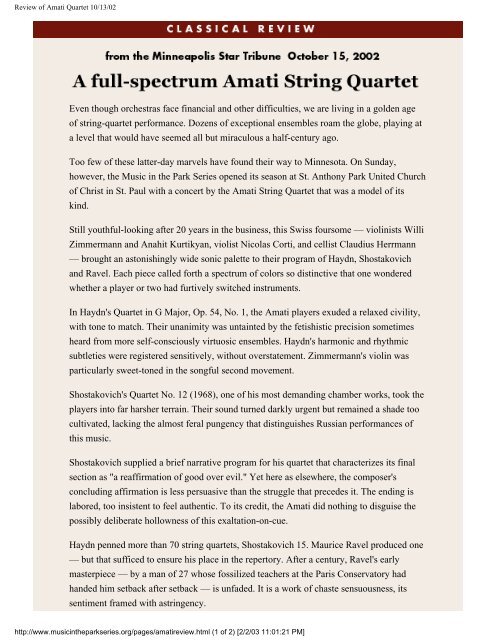Amati Quartet - Shupp Artists
Amati Quartet - Shupp Artists
Amati Quartet - Shupp Artists
- No tags were found...
Create successful ePaper yourself
Turn your PDF publications into a flip-book with our unique Google optimized e-Paper software.
Review of <strong>Amati</strong> <strong>Quartet</strong> 10/13/02Even though orchestras face financial and other difficulties, we are living in a golden ageof string-quartet performance. Dozens of exceptional ensembles roam the globe, playing ata level that would have seemed all but miraculous a half-century ago.Too few of these latter-day marvels have found their way to Minnesota. On Sunday,however, the Music in the Park Series opened its season at St. Anthony Park United Churchof Christ in St. Paul with a concert by the <strong>Amati</strong> String <strong>Quartet</strong> that was a model of itskind.Still youthful-looking after 20 years in the business, this Swiss foursome — violinists WilliZimmermann and Anahit Kurtikyan, violist Nicolas Corti, and cellist Claudius Herrmann— brought an astonishingly wide sonic palette to their program of Haydn, Shostakovichand Ravel. Each piece called forth a spectrum of colors so distinctive that one wonderedwhether a player or two had furtively switched instruments.In Haydn's <strong>Quartet</strong> in G Major, Op. 54, No. 1, the <strong>Amati</strong> players exuded a relaxed civility,with tone to match. Their unanimity was untainted by the fetishistic precision sometimesheard from more self-consciously virtuosic ensembles. Haydn's harmonic and rhythmicsubtleties were registered sensitively, without overstatement. Zimmermann's violin wasparticularly sweet-toned in the songful second movement.Shostakovich's <strong>Quartet</strong> No. 12 (1968), one of his most demanding chamber works, took theplayers into far harsher terrain. Their sound turned darkly urgent but remained a shade toocultivated, lacking the almost feral pungency that distinguishes Russian performances ofthis music.Shostakovich supplied a brief narrative program for his quartet that characterizes its finalsection as "a reaffirmation of good over evil." Yet here as elsewhere, the composer'sconcluding affirmation is less persuasive than the struggle that precedes it. The ending islabored, too insistent to feel authentic. To its credit, the <strong>Amati</strong> did nothing to disguise thepossibly deliberate hollowness of this exaltation-on-cue.Haydn penned more than 70 string quartets, Shostakovich 15. Maurice Ravel produced one— but that sufficed to ensure his place in the repertory. After a century, Ravel's earlymasterpiece — by a man of 27 whose fossilized teachers at the Paris Conservatory hadhanded him setback after setback — is unfaded. It is a work of chaste sensuousness, itssentiment framed with astringency.http://www.musicintheparkseries.org/pages/amatireview.html (1 of 2) [2/2/03 11:01:21 PM]


